Hot take: We think the upper back is the new abs. Sure, a shredded six-pack turns heads at the beach or pool, but a beefy upper back signals to the entire world that you hit the weights on a regular basis.
Not only that, but your upper back is essential for shoulder stability, power production, and overall upper body strength. In short, you need to train it. And these are 13 of our favorite upper back exercises for muscle and strength:
13 Best Upper Back Exercises
- Barbell Row
- Single-Arm Dumbbell Row
- TRX Row
- Single-Arm Landmine Row
- Seal Row
- Face Pull
- Hang Clean
- Seated Cable Row
- Lat Pulldown
- Wide-Grip Pull-Up
- Dumbbell Shrug
- Band Pull-Apart
- Deadlift
Editor’s Note: The content on BarBend is meant to be informative in nature, but it shouldn’t take the place of advice and/or supervision from a medical professional. The opinions and articles on this site are not intended for use as diagnosis, prevention, and/or treatment of health problems. Speak with your physician if you have any concerns.
1. Barbell Row
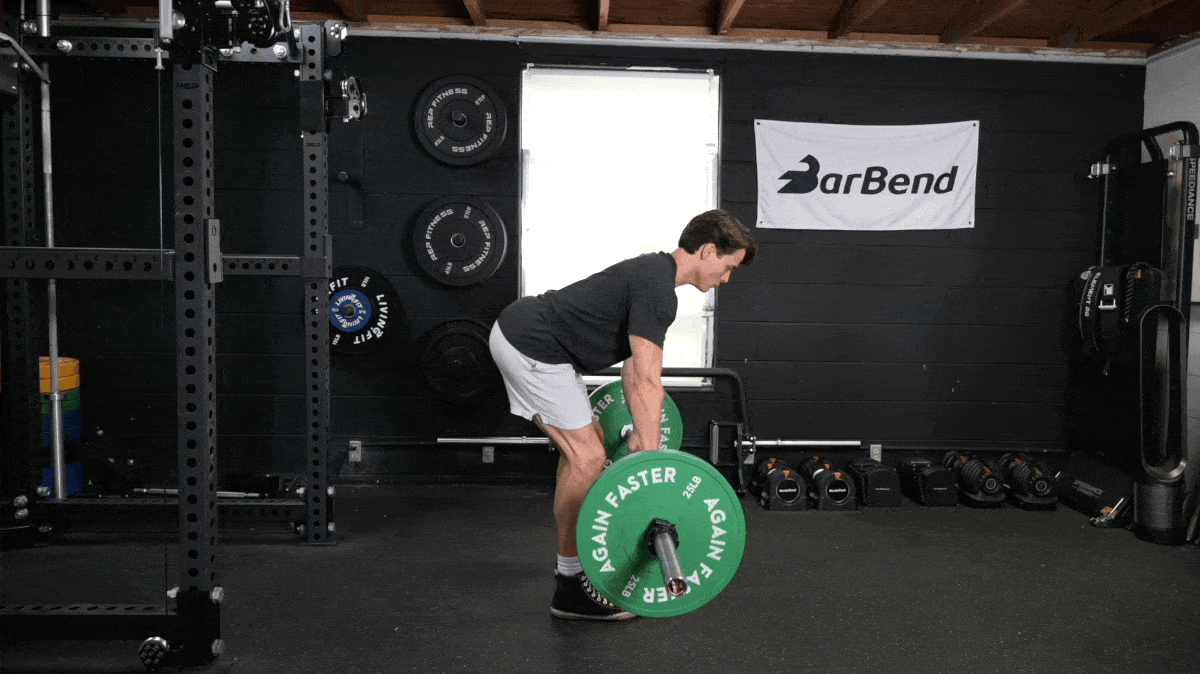
| Equipment Needed | Barbell, weight plates, lifting belt (optional), lifting straps (optional) |
| Muscles Worked | Lats, traps, rhomboids, lower back, biceps |
| Sets & Reps | 3 x 5-8 |
The barbell row strengthens your upper back, shoulders, biceps, grip and it’s the perfect accessory exercise for improving your deadlift.
The bent-over row also mimics the hip hinge and holding the hip hinge under load for time will help improve your lower and upper back endurance. This isn’t a glute exercise, but the row also reinforces good hip hinge mechanics, which will have a direct carryover to your deadlift.
How To Do It
- Hinge at your hips and grab a loaded barbell with a grip that’s slightly wider than shoulder-width.
- Squeeze your shoulder blades together and row the barbell until it’s touching your stomach; you want your elbows to be angled at about 45 degrees throughout the movement.
- Hold the top position of the row for a beat and then slowly lower the weight back down.
Modifications
- Make It Easier: You can use straps and a lifting belt to reduce the load on your back and secure your grip.
- Make It Harder: Try the Pendlay row, hinging until your torso is parallel to the floor and letting the bar rest on the ground between reps.
2. Single-Arm Dumbbell Row
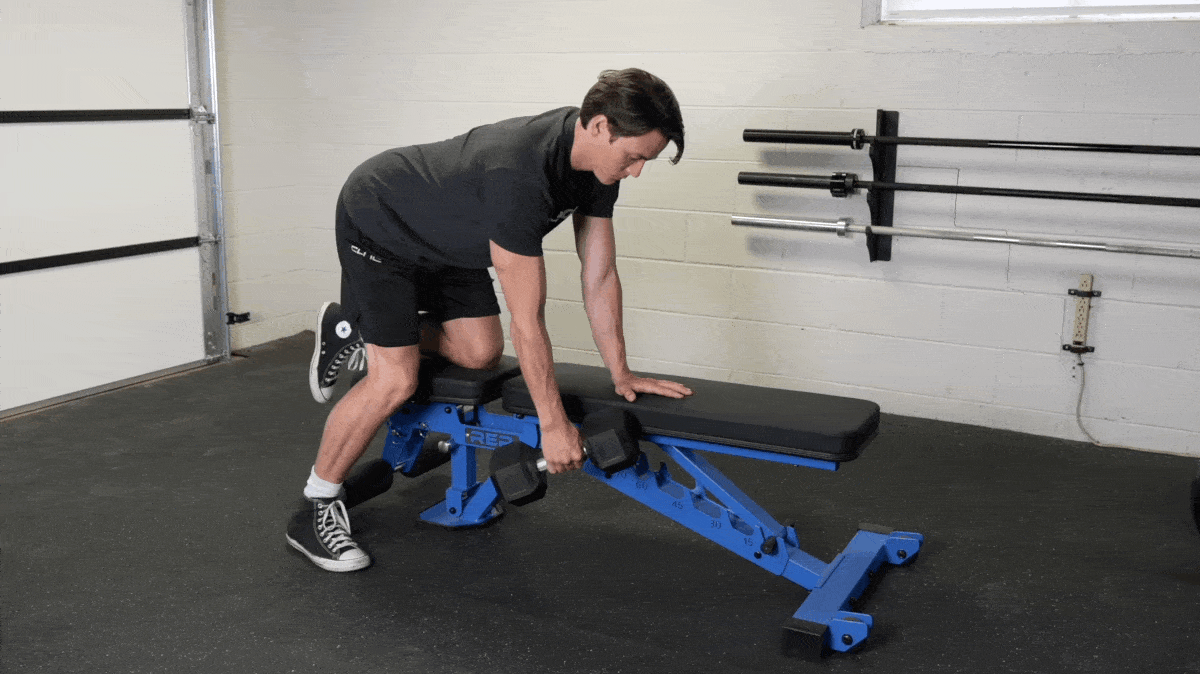
| Equipment Needed | Dumbbell, weight bench, lifting straps (optional) |
| Muscles Worked | Lats, biceps, traps, rhomboids |
| Sets & Reps | 2-3 x 8-12 |
There’s a multitude of variations to choose from with the single-arm dumbbell row. Single-arm dumbbell rows are one of the best upper back dumbbell exercises out there. Rows with one arm iron out strength imbalances that often exist between sides and you’ll get some extra core work in from having to brace your abdominal muscles, too.
How To Do It
- Kneel on a flat weight bench with the corresponding leg of your working arm kicked out behind you like a kickstand. Your other knee should be on the bench.
- Hinge over so your torso is mostly parallel to the floor and grab the dumbbell.
- Pull it up and into your same-side hip, leading with your elbow and keeping your upper arm tucked to your side.
3. TRX Row
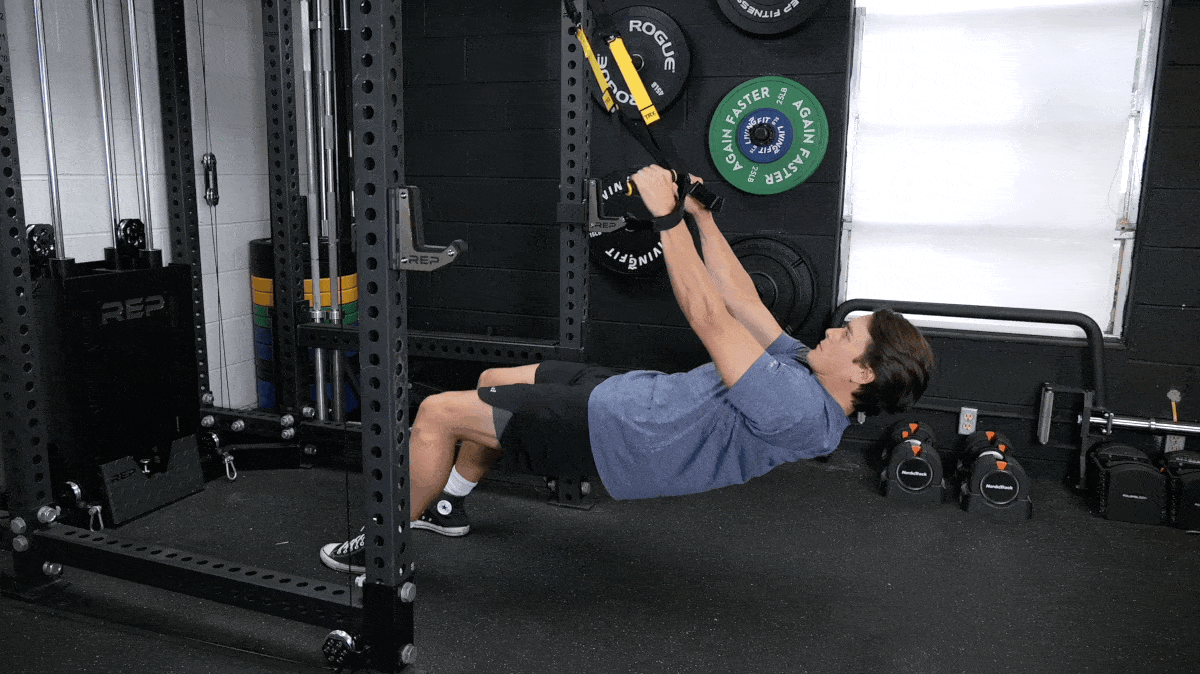
[Read More: The Best Back Exercises And Full Workouts To Build Muscle And Strength]
| Equipment Needed | TRX strap system |
| Muscles Worked | Lats, traps, forearms, core, glutes |
| Sets & Reps | 2-3 x 12-15 |
The beauty of the TRX is you can increase or decrease the intensity simply by adjusting the foot position closer or further away from the anchor point, which is great for beginners and advanced lifters alike.
This exercise when performed for higher reps will have you feeling your upper back muscles more than ever before. It’s also a great option for beginners who want work up to weight training, and/or people who want to avoid loading up their joints with weights. Because this is a bodyweight exercise, it’s generally easier on your joints.
How To Do It
- Hold the strap with one or two hands by your hips and walk feet towards the anchor point until you feel you have the right level of difficulty.
- Keeping your shoulders down and chest up, pull yourself towards the anchor point until you feel a contraction in your upper back. Slowly return to the starting position and repeat.
4. Single-Arm Landmine Row
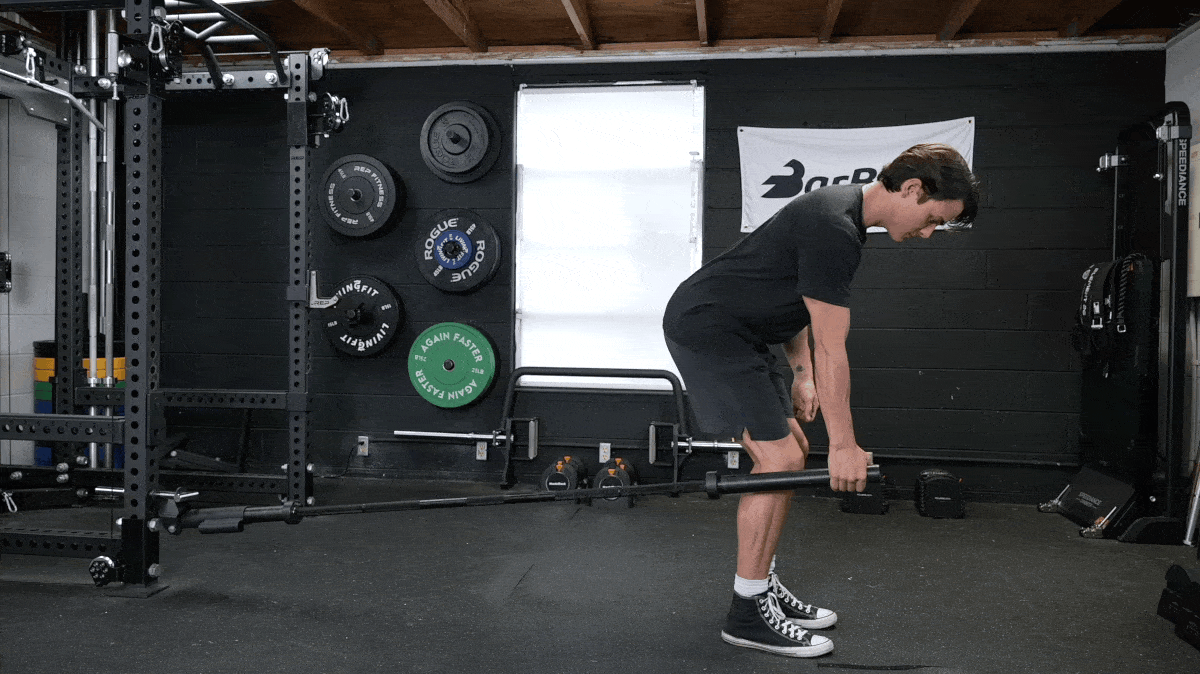
| Equipment Needed | Landmine base, barbell |
| Muscles Worked | Lats, rhomboids, core, lower back |
| Sets & Reps | 3 x 12-15 |
The single-arm landmine row is a unilateral exercise, meaning you work one side of your body at a time. This allows your weaker side to catch up to your dominant side, which, in the long run, will result in more overall strength.
Also, rowing a barbell that’s front-loaded with weight shifts the tension for a different feel — which some lifters may or may not like. But how is it better for your upper back? Mainly because you can more easily control the angle and positioning of your body in relation to the load — essentially rowing the weight right to your shoulder.
How To Do It
- Stand to the side of the barbell, loaded into a landmine apparatus, and hinge your hips back and rest your non-working hand on your knee and grab the barbell.
- Keeping your chest up and shoulders down, pull towards your hip until you feel a strong contraction in the upper back. Slowly lower down and repeat.
Modifications
- Make It Easier: You can use a lifting strap if the sleeve of the bar is too thick to hold.
- Make It Harder: Try this one with a thumbless grip to make your forearms burn.
5. Seal Row
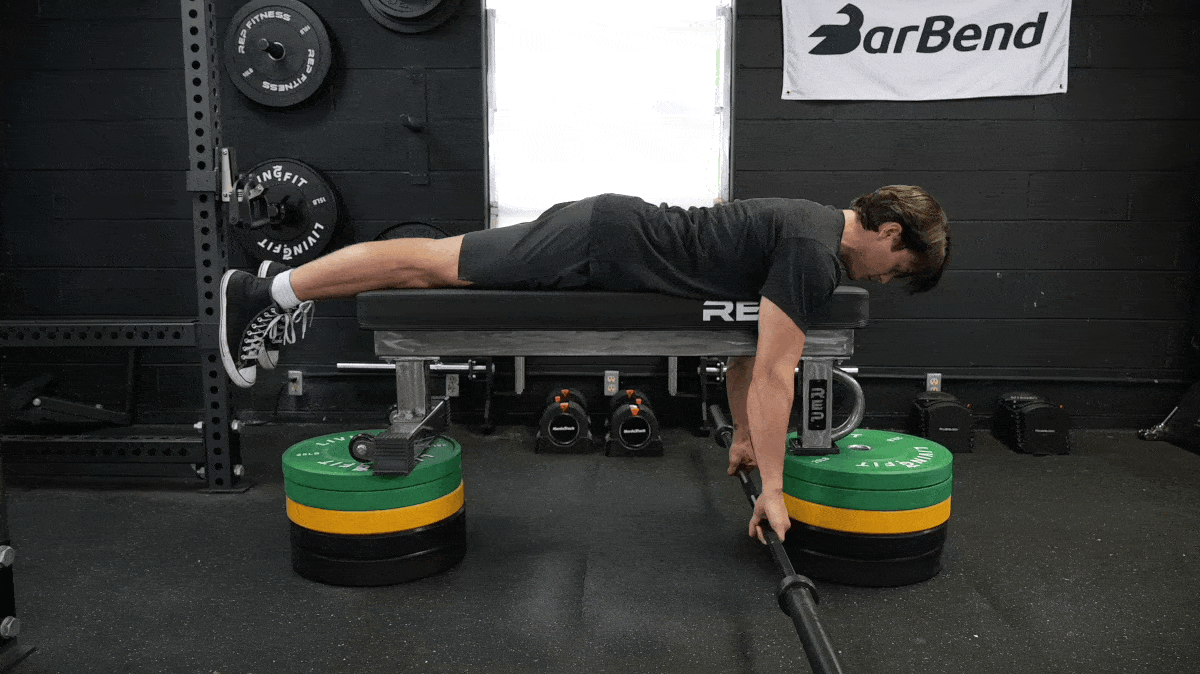
| Equipment Needed | Barbell, weight plates, weight bench, bumper plates or plyo boxes |
| Muscles Worked | Lats, traps, rhomboids, biceps |
| Sets & Reps | 2-3 x 10-12 |
The seal row is a rowing variation that has you lay face down on an elevated workout bench, holding a barbell with both hands so that it’s not touching the floor. This prone position takes any and all momentum out of the movement so that your upper back muscles are doing all of the (literal) heavy liftings.
[Read More: The Best Upper Body Exercises and Workout Routines]
Most lifters go heavy with rows and use more biceps and less scapula retraction which leaves the rhomboids neglected. This exercise solves both of these issues; the prone position takes away all momentum, so you can really isolate the target area. It’s also a lower-back friendly variation, as it’s not working to support you in any sort of hinged position.
How To Do It
- Set up on a bench so that you can fully extend your arms without the barbell touching the ground. Do this by propping up a bench on either two low boxes or a stack of bumper plates.
- Then, lie face down on the bench with the barbell underneath you and squeeze your glutes and brace abs.
- Think about pulling your elbows towards the hip as the barbell touches the bench. Lower down to the floor and repeat.
6. Face Pull
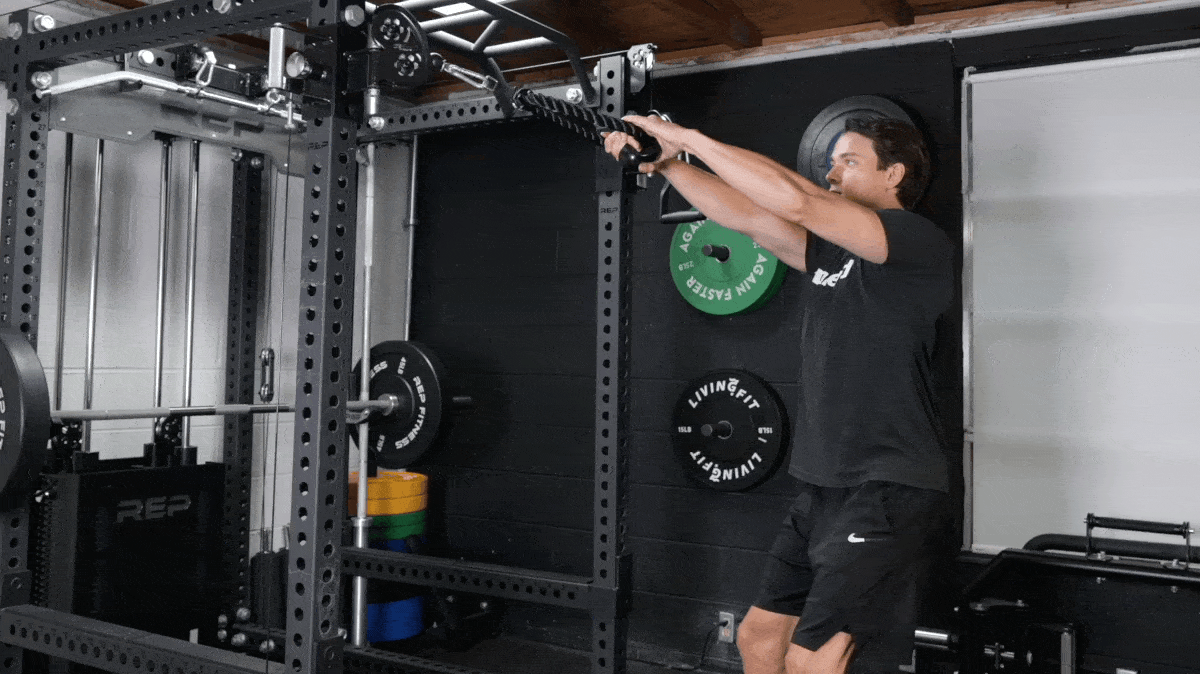
| Equipment Needed | Adjustable cable station, rope attachment |
| Muscles Worked | Traps, rhomboids, teres major & minor, rear delts |
| Sets & Reps | 2-3 x 15-20 |
Face pulls will help add size, strength, and endurance to the rear shoulders and upper back. This is also one of the best exercises for upper back pain because the external rotation at the end of the movement will help pull the shoulders back so you’re really activating the traps and rhomboids, which are primary movers in scapular retraction.
[Read More: The Most Effective Workout Splits, Created by Our Experts]
Be sure not to go too heavy because you want to ‘feel’ those muscles working and not let your biceps take over. You can also do these anywhere as long as you have a quality resistance band. The face pull increases shoulder strength, scapular stability, and strengthens external rotation. It’s a great low-intensity exercise that can be paired with strength exercises that need upper back strength and good posture.
How To Do It
- Hold the rope with an overhand grip with your thumbs up, and then walk back until your arms are outstretched.
- Get into an athletic stance, activating your core and glutes and with your shoulders down and chest up.
- Squeeze your shoulder blades together as you pull the rope towards your face. Hold this position for two seconds and return to the starting position.
Modifications
- Make It Easier: You can do this one lying down on your back instead of standing up for more stability.
- Make It Harder: Try pausing at the end of each rep and pretend you’re performing a double-biceps pose with your arms.
7. Hang Clean
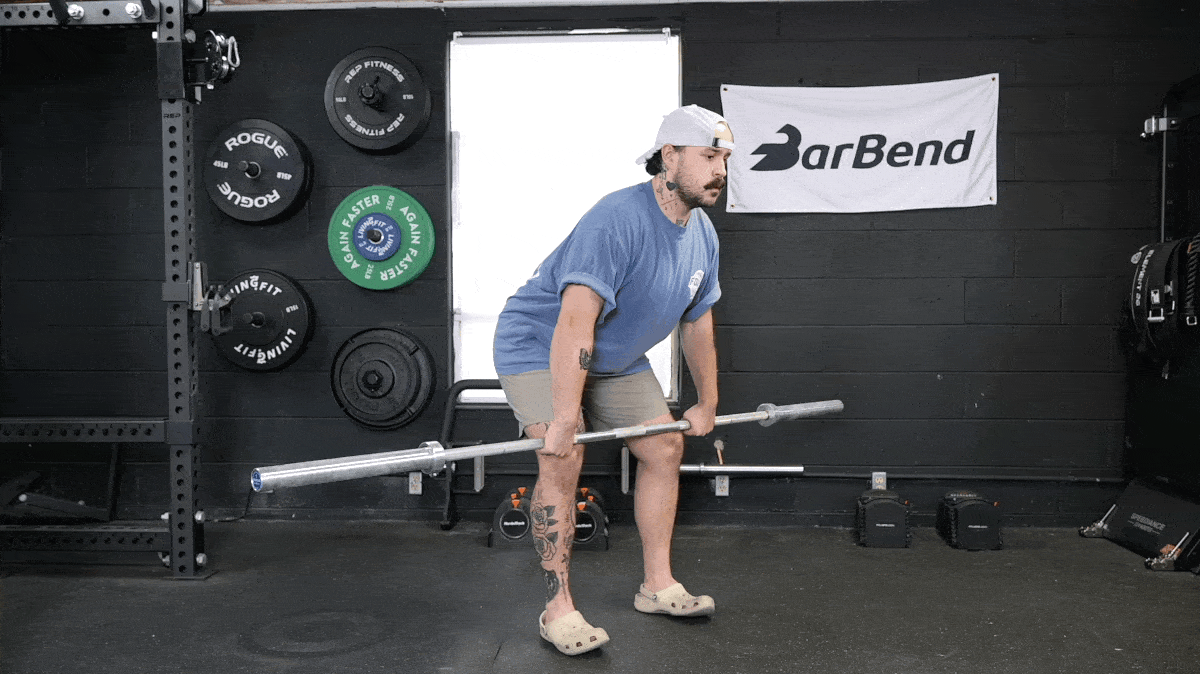
| Equipment Needed | Barbell, bumper plates, weightlifting shoes (optional), lifting platform (optional) |
| Muscles Worked | Quads, traps, core |
| Sets & Reps | 3-5 x 3-5 |
Nothing against the power clean, which is a staple in most professional weight rooms. But the hang clean has a shorter learning curve, and you can generate power from a lower-back-friendly position.
The hang clean still requires a powerful leg drive, a strong pull, and the classic dip-and-catch. The catch in the front rack will help develop a bigger yoke.
How To Do It
- Stand tall with the barbell at arm’s length with an overhand grip, and feet shoulder-width apart.
- Hinge at the hips until the bar is at your knees.
- Push your feet into the floor and snap your hips so the bar flies upward. Drop into a squat and catch the bar in the front rack position.
Modifications
- Make It Easier: You can try the hang muscle clean, which doesn’t require you to dip into a quarter or half squat to catch the bar.
- Make It Harder: Add weight and rip some full-depth cleans.
8. Seated Cable Row
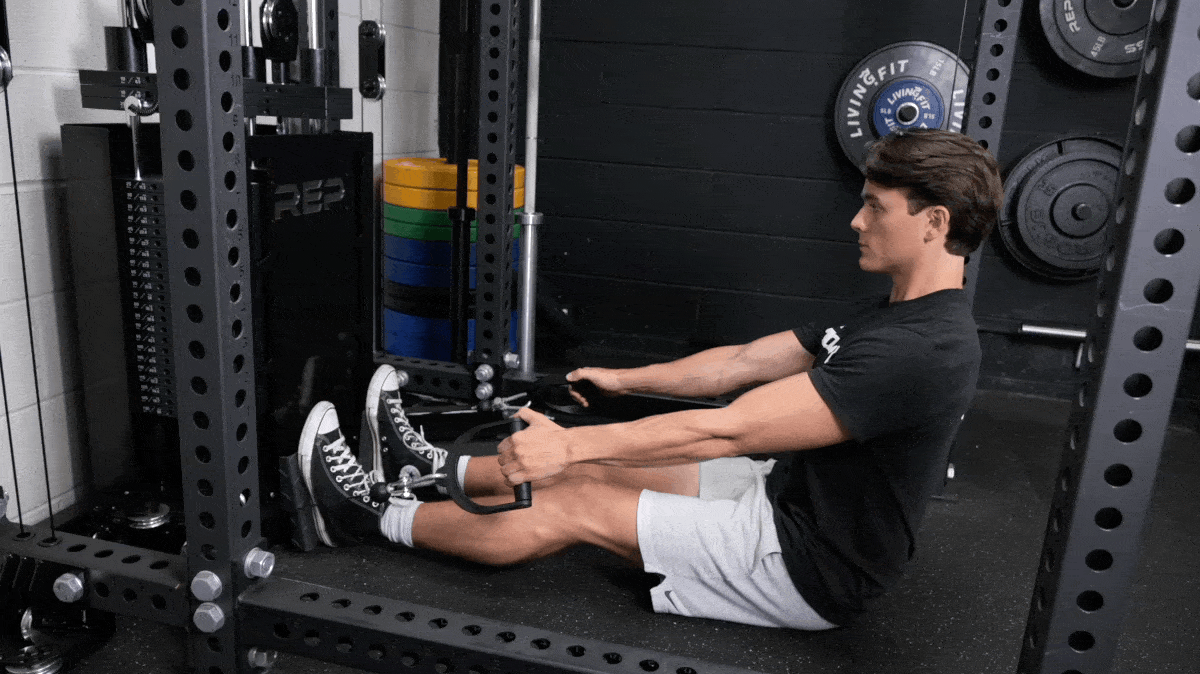
| Equipment Needed | Seated cable rowing station, attachment of choice |
| Muscles Worked | Traps, lats, rhomboids, rear delts |
| Sets & Reps | 3-4 x 12-15 |
We like cable back workouts for their versatility. Simple adjustments can change which muscles you’re targeting. To prioritize your upper back, hit up the seated cable row. This move targets most of your upper back muscles, and will apply smooth, consistent mechanical tension.
How To Do It
- Fix your attachment of choice to a seated cable row station.
- Grab the attachment with a shoulder-width or slightly wider grip and scoot back on the bench to pull the cable taut.
- Pull the attachment toward your ribcage by drawing your shoulders backward and then following through with your elbows.
Modifications
- Make It Easier: Use straps to secure your hands to the bar attachment.
- Make It Harder: Try doing this move with one arm at a time by attaching a D-handle to the carabiner.
9. Lat Pulldown
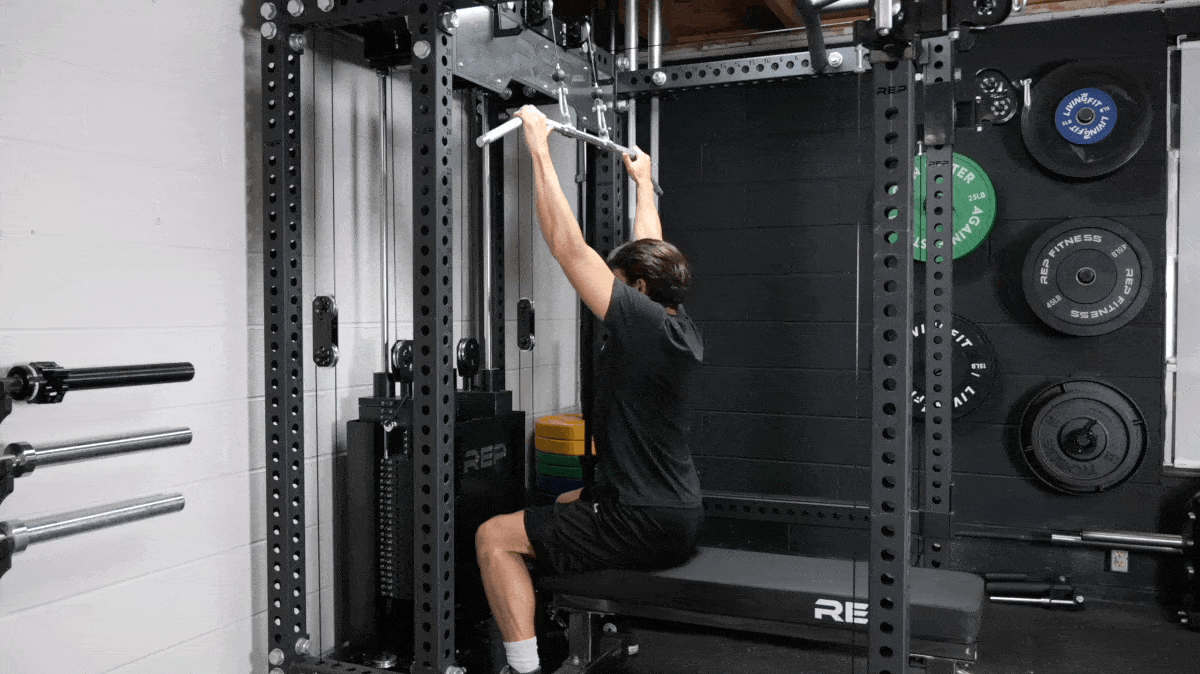
| Equipment Needed | Lat pulldown station or adjustable cable station, attachment of choice |
| Muscles Worked | Lats, traps, rhomboids, rear delts |
| Sets & Reps | 2-3 x 8-15 |
The lat pulldown is a back-building staple. While some folks use it to emphasize their lats, we think it works just as well as an upper-back builder. By widening your grip and flaring your elbow, you can target the muscles around your shoulder blades.
How To Do It
- Sit down at the cable station after attaching a long straight bar attachment and gripping it with a shoulder-width (or slightly wider), double-overhand grip.
- Lean back very slightly and allow the cable to pull your shoulders up toward your ears.
- Pull the attachment down to your upper chest by depressing your shoulders and then pulling your elbows down.
Modifications
- Make It Easier: If the lat pulldown station is uncomfortable, you can also do this move by sitting down while facing an adjustable cable pulley.
- Make It Harder: Pause at the end of each repetition, holding the bar gently against your torso and contracting your upper back hard.
10. Wide-Grip Pull-Up
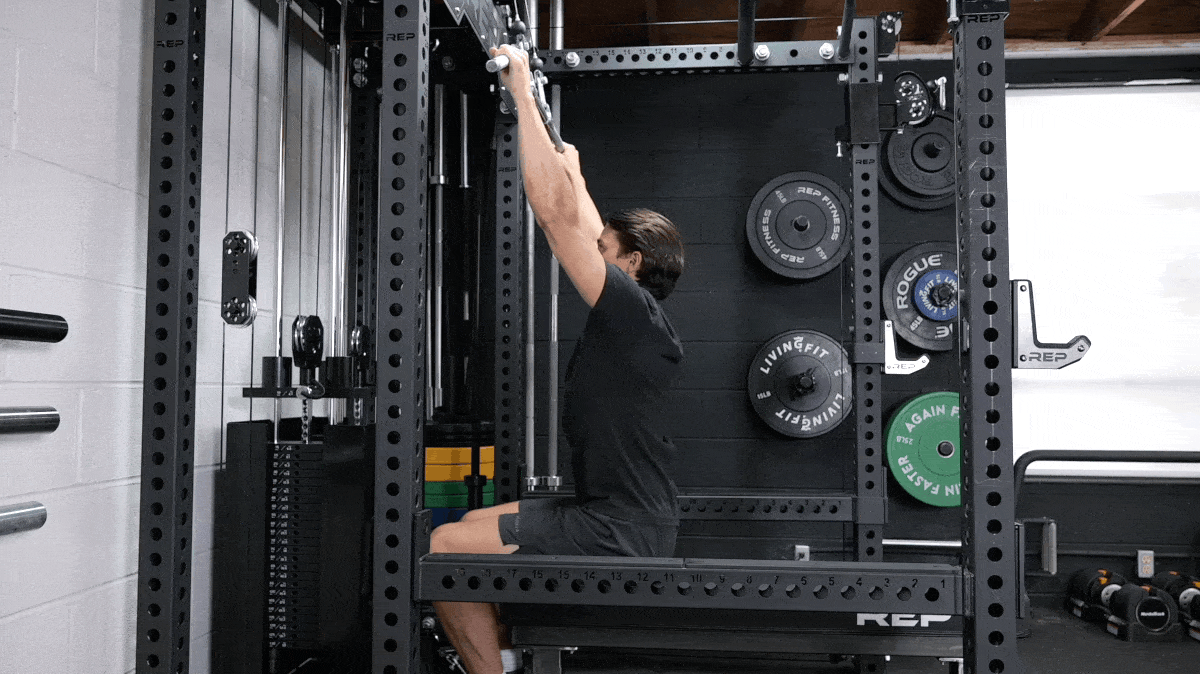
| Equipment Needed | Pull-up bars, lifting straps (optional) |
| Muscles Worked | Lats, traps, rhomboids, rear delts, brachialis, core |
| Sets & Reps | 2-3 x 6-15 |
We know, we know — pull-ups are a tough nut to crack for a lot of people. But they’re also a top-tier back-building exercise that we recommend you do if you want to build muscle and strength. The wide-grip pull-up is difficult, but will target your upper back muscles like nothing else.
How To Do It
- Hang from a pull-up bar with an overhand, wider-than-shoulder-width grip, allowing your shoulders to pull up toward your ears.
- Brace your core and initiate the move by depressing your shoulders down away from your head and then using your arms to pull your body up to the bar.
Modifications
- Make It Easier: You can use a band around your feet or work with the assisted pull-up machine if standard bodyweight pull-ups are too challenging.
- Make It Harder: Try one-and-a-half reps during the top half of the range of motion.
11. Dumbbell Shrug
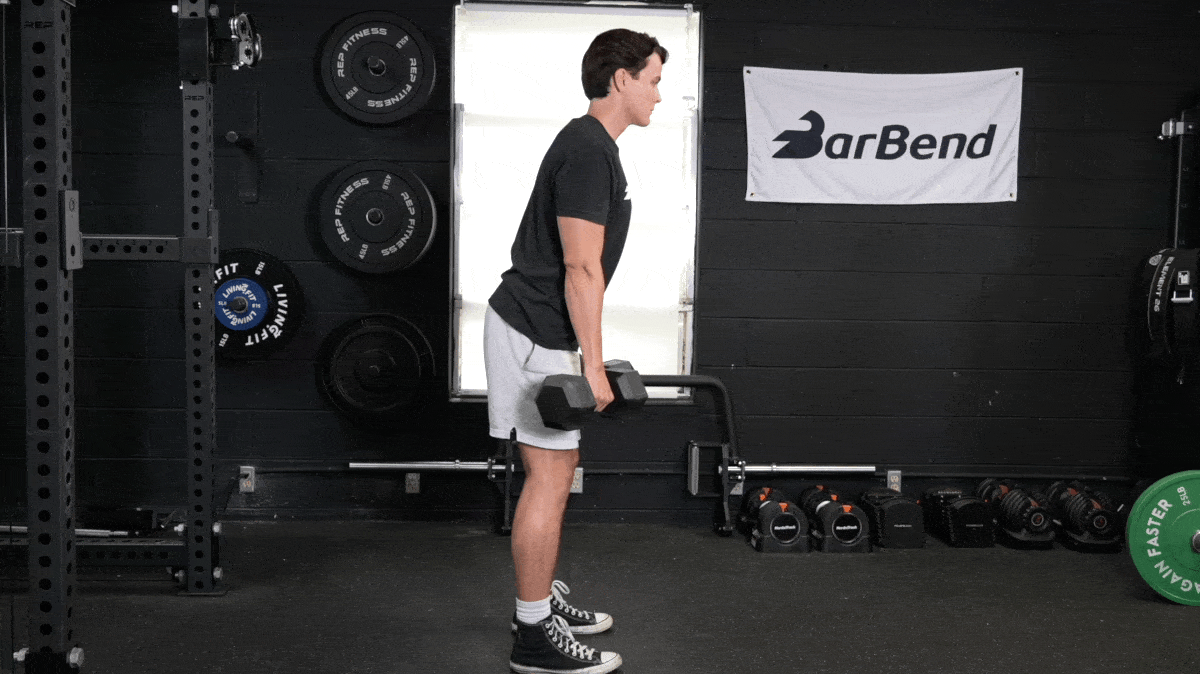
| Equipment Needed | Dumbbells, lifting straps (optional) |
| Muscles Worked | Traps, forearms |
| Sets & Reps | 2-3 x 12-15 |
Dumbbell shrugs let you isolate your traps, which contribute strongly to the overall appearance and performance of your upper back. You can do shrugs with just about any implement, but we recommend using dumbbells because they allow you to elevate and lower your shoulders independently.
How To Do It
- Stand upright while holding a moderate-to-heavy dumbbell in each hand.
- Brace your core and then shrug your shoulders as high as you can.
Modifications
- Make It Easier: You can sit down and/or use lifting straps to improve your comfort on this exercise.
- Make It Harder: At the end of each set, perform a static hold with the weights for 10 to 20 seconds before setting them down.
12. Band Pull-Apart
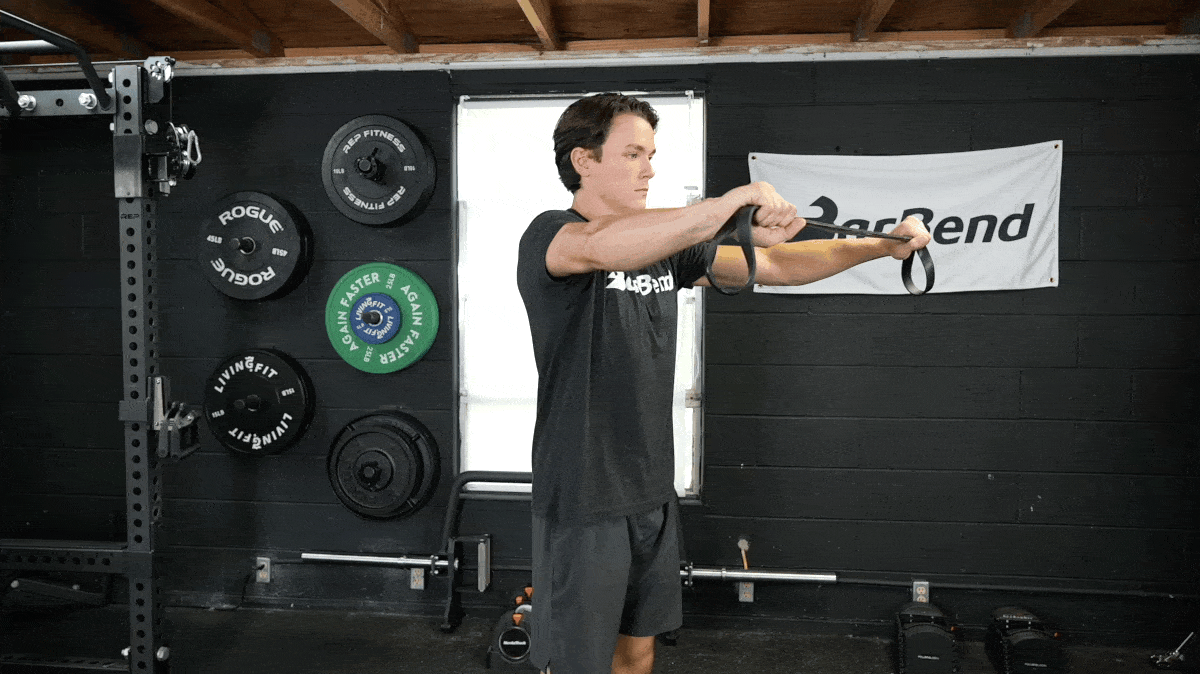
| Equipment Needed | Resistance band |
| Muscles Worked | Traps, rear delts, rhomboids |
| Sets & Reps | 2-3 x 15-25 |
Not every upper back exercise needs to be hard and heavy. That region of your back is actually made up of many, many different small muscles, some of which require a more delicate touch if you want them to grow.
You can grab a resistance band and stimulate the muscles that attach to and affect your scapula, such as the posterior deltoid or supraspinatus, by performing pull-aparts. This exercise offers targeted muscular stimulation without having to turn to heavy weights.
How To Do It
- Grab ahold of a resistance band with a slightly-wider-than-shoulder-width grip and hold it aloft in front of your body with your arms straight.
- From here, pull your arms out to each side as though you were going to tear the band apart.
- Spread your arms until they’re in line with your torso, hold for a beat to feel your upper back contract, and then return to the starting position.
13. Deadlift
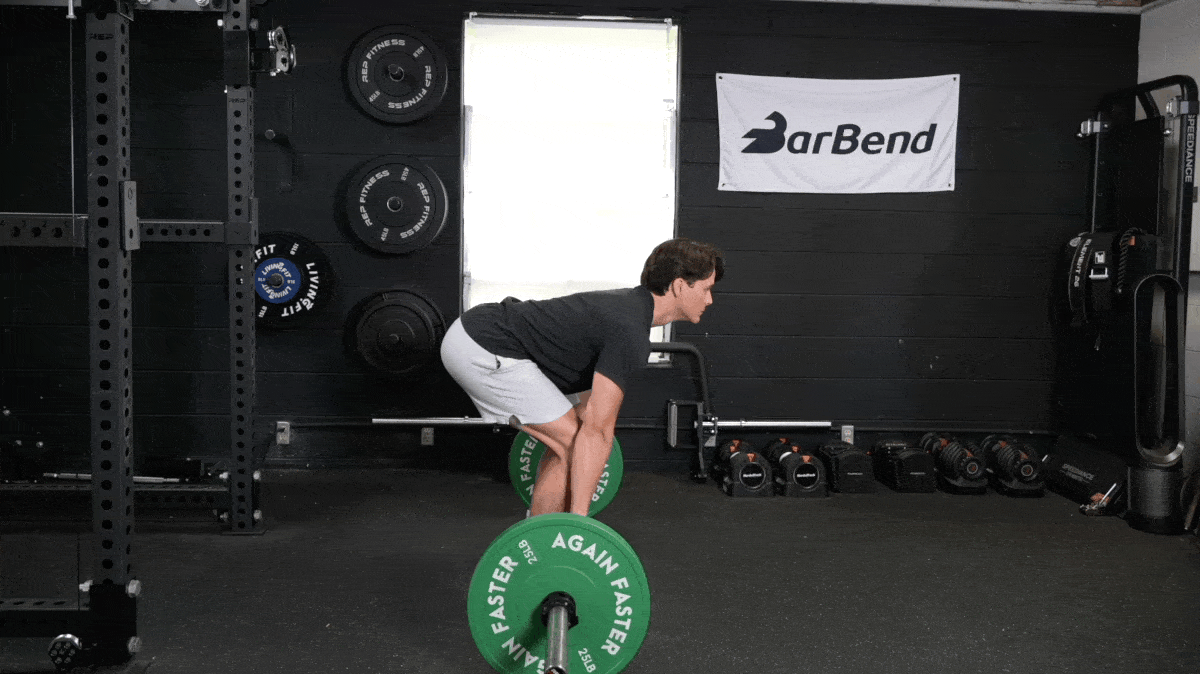
[Read More: The Single-Leg Deadlift Is the Best Pulling Accessory You’re Not Doing]
| Equipment Needed | Barbell, weight plates, barbell collars |
| Muscles Worked | Glutes, hamstrings, back, traps |
| Sets & Reps | 3 x 5 |
The deadlift is one of the best compound exercises you can do, period,” notes Dickson. When it comes to upper back training, he says you should include at least one heavy compound pulling exercise like the deadlift to develop isometric upper back strength.
“Deadlifts don’t train your upper back as well as more specific movements do, but everyone should perform some form of deadlift on a regular basis,” Dickson continues. “Deadlifts teach you an essential movement pattern for everyday life.”
How To Do It
- Stand in front of a loaded barbell with your feet shoulder-width apart, hips back, and back flat.
- The knees should be bent slightly to allow you to grip the bar tightly, slightly wider than shoulder-width.
- Keeping your back flat and chest up, tighten the back muscles, and straighten your arms as you load the pull.
- With everything locked, aggressively push your legs into the floor as you simultaneously pull your chest and shoulders upwards, lifting the bar to the hip.
Modifications
- Make It Easier: If you’re new to deadlifting, perform the movement with a kettlebell first (called a kettlebell deadlift).
- Make It Harder: Add more weight or perform more reps. You can also do deficit deadlifts to increase the range of motion of your pull.
4 Upper Back Workouts To Try
The movements in this article are all well and good on their own, but if you want to build and strengthen your upper back muscles, you need workouts designed to do so. Here are three of our favorites.
Upper Back Warm-Up
Before doing any exercises that involve the upper back, it’s important to get blood flow there and then mobilize it with a few low-intensity exercises to help get your upper body in good exercise positions. A good upper back warm-up should include cardio, upper back stretches, and a few primers as well:
- 5 to 10 minutes of low-intensity cardiovascular exercise.
- Foam roll or dynamically stretch the upper back muscles if you feel stiff or immobile.
- Perform low-intensity, low-load upper back exercises like face pulls or pull-aparts to engage the muscles.
Upper Back Workout for Beginners
As a beginner, you need to learn your body’s fundamental movement patterns. This means mastering pulling technique by using different equipment at different angles.
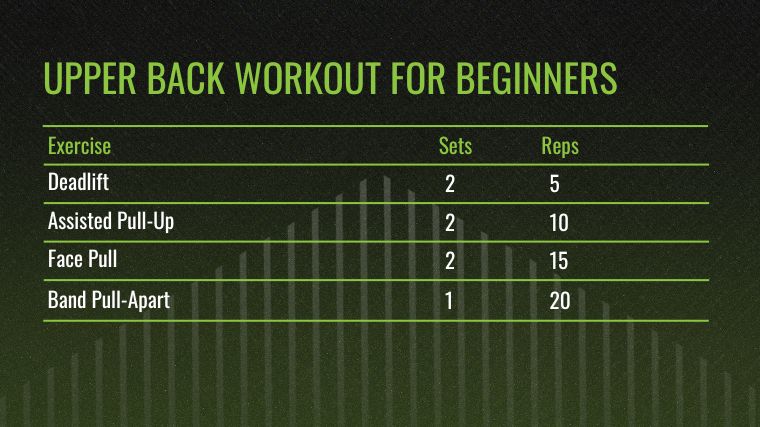
- Deadlift: 2 x 5
- Assisted Pull-Up: 2 x 10
- Face Pull: 2 x 15
- Band Pull-Apart: 1 x 20
Upper Back Workout for Muscle
Muscle hypertrophy is all about stimulating the tissues you want to grow with mechanical tension and good form. To that end, we prefer plenty of cable and machine exercises that remove the stability demand and allow you to focus on what matters; blasting through the best upper back workout you can do to build muscle.
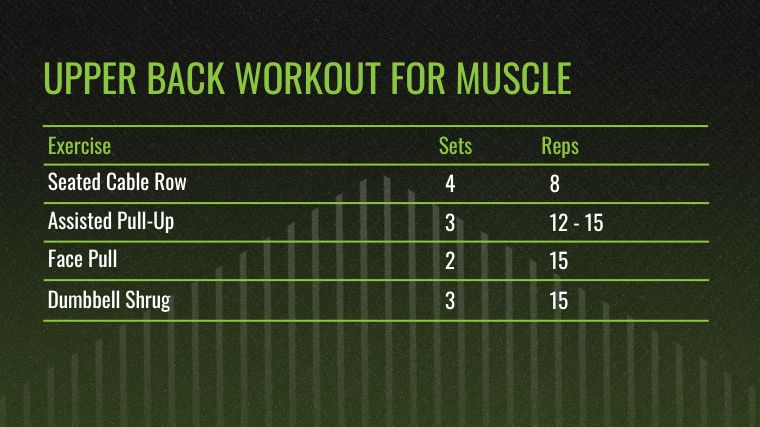
- Seated Cable Row: 4 x 8
- Assisted Pull-Up: 3 x 12-15
- Face Pull: 2 x 15
- Dumbbell Shrug: 3 x 15
Upper Back Workout for Strength
If you want the right exercises to strengthen your upper back, look no further. These moves focus on shoulder stability and pulling power simultaneously.
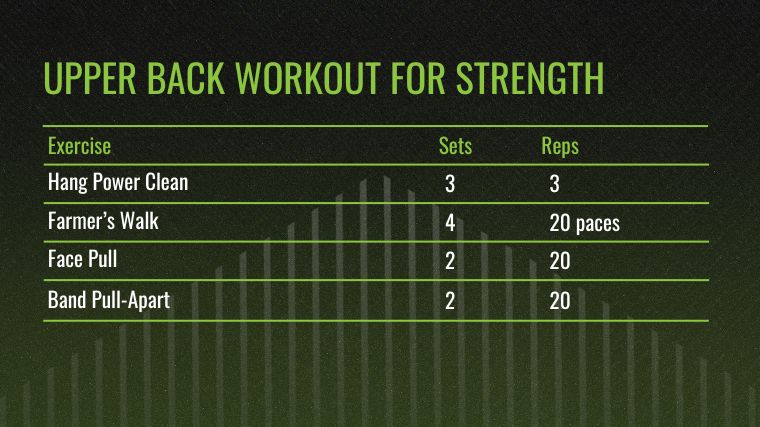
[Read More: Powerbuilding Workout Routine, With Tips from a CPT]
- Hang Power Clean: 3 x 3
- Farmer’s Walk: 4 x 20 paces
- Face Pull: 2 x 20
- Band Pull-Apart: 2 x 20
Upper Back Workout To Prevent Back Pain
“If you’re injured, you should seek assistance from a medical professional before performing any workout in that area,” recommends Dickson. That said, we think safely and conservatively training your upper back is one of the best ways to manage and prevent pain from poor posture.
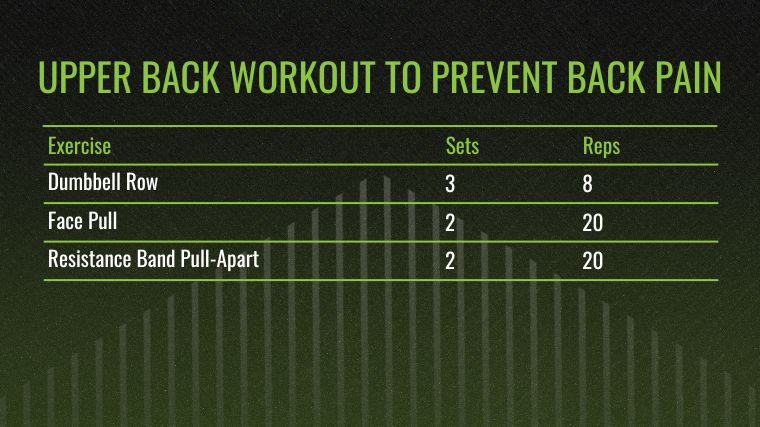
- Dumbbell Row: 3 x 8
- Face Pull: 2 x 20
- Resistance Band Pull-Apart: 2 x 20
How To Train Your Upper Back
Your upper back is an intricate web of musculature. It’s not as simple as, say, your biceps or triceps. Your scapula, or shoulder blade, moves freely along your ribcage, providing ample range of motion. This also means you can utilize a very wide assortment of exercises when designing an upper back workout. Here’s what you need to keep in mind.
Upper Back Exercise Selection
Truth be told, any upper-body pulling movement will engage your upper back to some degree. However, if you want to target the muscles towards the top of your back, you should be selective about both the exercises you execute and the technique you utilize.
To bias your rhomboids, traps, and rear delts more than your lats, remember that your row grip matters. Go for wide-grip pulls like the face pull or inverted row. Close-grip or underhanded rowing movements are more likely to target your lats.
[Read More: The Best Pull Exercises to Forge a Bigger, Stronger Back]
Further, certain movements like the barbell row may not be effective for your upper back if you don’t have the posterior chain strength to support good posture throughout an entire set. Choose your movements carefully and don’t be afraid to rely on resistance bands, cables, or exercise machines.
Upper Back Sets and Reps
Once you’ve determined which exercises belong in an upper-back-focused workout, it’s time to unfurl the remainder of the programming. The next step is selecting your sets and reps. Err on the side of higher repetitions overall, since many of the upper back muscles are small and intricate and can fatigue easily.
- For Muscle Mass: 2 to 4 sets of 10 to 15 repetitions is a good starting point, with certain isolation movements like the pull-apart benefitting from even higher rep counts in some cases.
- For Strength: On compound exercises, keep things simple with 3 to 4 sets of 5 to 8 repetitions. If you’re performing dynamic moves like the power clean, consider five reps to be your limit.
Upper Back Training Tips
To get the most value out of your upper back workouts, you need more than a solid workout routine in your back pocket. Employ these training tips during your next session to reap the most results:
Find Your Line of Pull
Some people find it difficult to establish a good mind-muscle connection with their upper back. These muscles support good posture and control the articulation of your shoulder; however, you may not have experience contracting them consciously.
Adjusting the angle of your pull on a certain exercise can help you “turn on” your upper back muscles by giving them better leverage. For instance, flaring your elbows when you row and pulling the weight higher on your chest should help you engage your rhomboids and rear delts a bit more than if you used a tucked-arm position.
Use Straps
All back workouts benefit from lifting straps to some degree. A strong grip is invaluable for strength sports, but you shouldn’t let your hand or forearm strength be the rate limiter of your upper back growth. Your traps may have more to give, but if you can’t hold onto the bar for a set of shrugs, what’s the point?
[Read More: The Best Forearm Exercises for Strength, Plus 4 Workouts]
As you approach a fatigued state, turn to lifting straps. They will ensure you get the most bang for your buck on every working set. And don’t worry about losing out on forearm gains; you can always train them separately afterwards.
Benefits of Training Your Upper Back
Upper back strength and size plays a role in posture, strength, and spinal stability. Here are the main benefits you can reap from targeting your upper back muscles.
Builds a Stable Base
During the squat, the upper back provides a place for the bar to sit, and keeping the upper back tight prevents you from leaning too far forward in the squat and turning the movement into a good morning.
During the bench press, the upper back provides the foundation on which to press. By keeping the upper back engaged, it supports and controls the bar path, allowing for good technique and — hopefully —pressing more weight.
Strengthened Posture
The muscles in your upper back are responsible for pulling your shoulder blades together. Most people spend way too much time sitting down or curled over, and as such, those muscles may grow weak over time.
It’s a cyclical issue where hunching causes weak muscles and weak muscles enable hunching. Being hunched over for long periods of time can also cause back pain and impede shoulder mobility. And decreased shoulder mobility can lead to poor form and, as a result, injury.
By strengthening the upper back muscles, you’re enabling better posture and therefore better pulling and overhead pressing form (due to increased shoulder mobility).
What Muscles Make Up the Upper Back
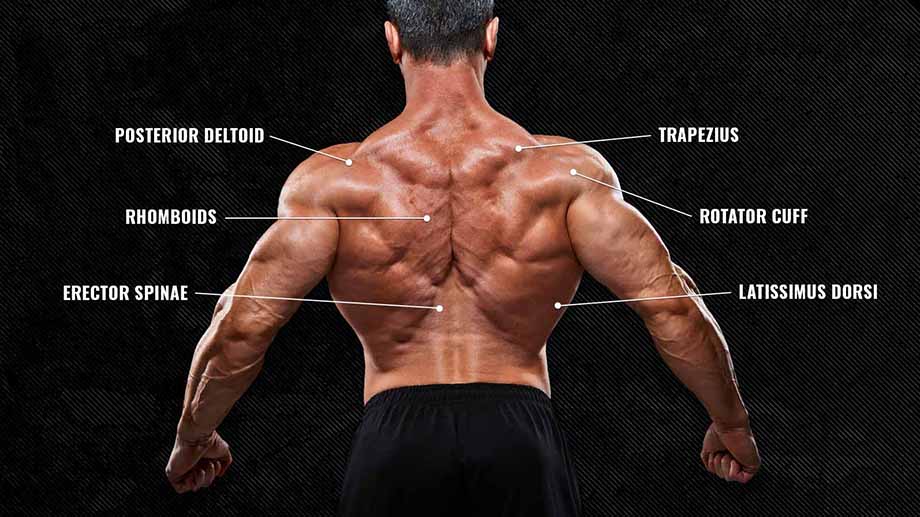
[Read More: Improved Posture for Bigger Lifts and Better Exercise]
Your upper back has important muscles and understanding what they are and how they work is important in obtaining a stronger, better-looking upper back. Here’s a breakdown of the major upper back muscles.
- Rhomboids: The rhomboids originate from the cervical (neck) vertebra and run diagonally down the back and attach to the inside of the scapula. Their functions include adduction, inward rotation of the arms, and scapular elevation.
- Trapezius: The trapezius is a large flat triangular superficial muscle that sits on both sides of the upper back. It originates from the cervical spine and all 12 of the thoracic vertebrae. The traps main functions include scapular adduction, elevation, depression, and outward rotation.
- Rear Deltoid: Your deltoid is made up of three distinct compartments. The posterior compartment helps maintain stability within the shoulder capsule, particularly when you perform pressing movements.
More Upper Back Training Tips
Now that you have a handle on the best upper back exercises to strengthen your entire upper back region you can also check out these other helpful back training articles for strength, power, and fitness athletes.
- 4 Challenging Pull-Apart Variations For A Stronger Upper Back
- 4 Single Arm Row Variations To Build A Serious Upper Back
Frequently Asked Questions
How many upper back exercises should you do in a workout?
It depends on your experience level. Generally speaking, you’ll do well with one horizontal pulling exercise (where your body is parallel to the ground) and one vertical pulling movement where your torso is upright.
What exercises can help relieve upper back pain?
People tend to experience upper back or neck pain from overuse, poor posture, or acute injury. Your first step should be to consult a qualified physician or physical therapist. Beyond that, try some upper back stretches or exercises for upper back pain like Y-raises, dead hangs, or band pull-aparts.
What is the best way to workout the upper back at home?
You can perform a few different upper back moves without needing to hit the gym. Stuff a suitcase full of clothing to do shrugs or farmer’s walks, or purchase a resistance band for pull-aparts or face pulls.
Featured Image: Rawpixels.com / Shutterstock